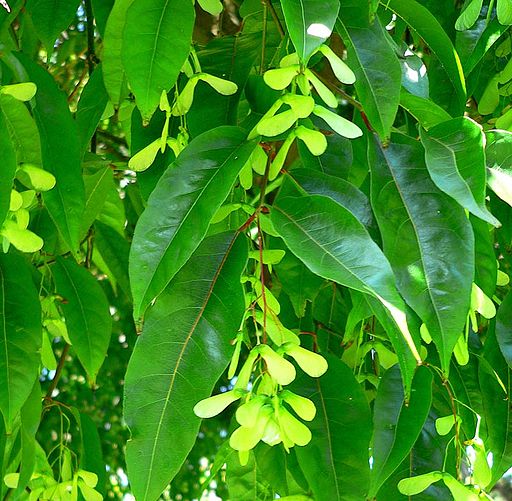Classification System: APG IV
Superregnum: Eukaryota
Regnum: Plantae
Cladus: Angiosperms
Cladus: Eudicots
Cladus: Core eudicots
Cladus: Rosids
Cladus: Eurosids II
Ordo: Sapindales
Familia: Sapindaceae
Subfamilia: Hippocastanoideae
Tribus: Acereae
Genus: Acer
Section: Acer sect. Palmata
Species: Acer laevigatum
Varietates: A. l. var. laevigatum – A. l. var. salweenense
Name
Acer laevigatum Wall., Pl. Asiat. Rar. 2: 3 (1830).
References
Additional references
Gelderen, D.M. van, Jong, P.C.de & Oterdoom, H.J. 1994. Maples of the world. Timber Press, Portland, Or., 458 pp. ISBN 0-88192-000-2. Reference page.
Govaerts, R.H.A. 1995. World Checklist of Seed Plants 1(1, 2). 483, 529 pp. MIM, Deurne. ISBN 90-341-0852-X (issue 1) ISBN 90-341-0853-8 (issue 2). Reference page.
Grierson, A.J.C. & Long, D.G. 2001. Flora of Bhutan 2: 1–1675. Royal Botanic Gardens, Edinburgh. ISBN 1-872291-02-3 Reference page.
Hsu, T.Z., Chen, Y.S., Jong, P.C.de, Oterdoom, H.J. & Chang, C.S. 2008. Acer. Pp. 537 in Wu, Zh.Y. , Raven, P.H. & Hong, D.Y. (eds.), Flora of China. Volume 11: Oxalidaceae through Aceraceae. Science Press, Beijing & Missouri Botanical Garden Press, St. Louis, ISBN 978-1-930723-73-3. efloras PDF Reference page.
De Langhe, J. & Crowley, D. 2017. Acer and Dipteronia: vegetative key to species in cultivation. Ghent University Botanical Garden: 222 p., pdf. Reference page.
Links
Crowley, D., Barstow, M. & Rivers, M.C. 2018. Acer laevigatum. The IUCN Red List of Threatened Species 2018. IUCN Red List Category: Least Concern. DOI: 10.2305/IUCN.UK.2018-1.RLTS.T194699A2358843.en.
USDA, ARS, Germplasm Resources Information Network. Acer laevigatum in the Germplasm Resources Information Network (GRIN), U.S. Department of Agriculture Agricultural Research Service. Accessed: 08-Apr-12.
Govaerts, R. et al. 2020. Acer laevigatum in Kew Science Plants of the World online. The Board of Trustees of the Royal Botanic Gardens, Kew. Published online. Accessed: 2020 January 8. Reference page.
International Plant Names Index. 2020. Acer laevigatum. Published online. Accessed: 8 January 2020.
Vernacular names
English: Smoothbark Maple
中文: 海南槭
Acer laevigatum, the smooth maple or Nepal maple, is an atypical species of maple native to southern China (Guizhou, Hong Kong, Hubei, Shanxi, Sichuan, Xizang, Yunnan), northern India (Arunachal Pradesh, Sikkim), northern Myanmar, Nepal, and northern Vietnam. It grows at moderate altitudes of 1,000-2,000 m, with a wet monsoon climate.[1][2]
Acer laevigatum is an evergreen tree growing to a height of 10–15 m or more, with a trunk up to 50 cm diameter. The leaves are smooth, unlobed, leathery, olive-green, and about 6–15 cm long and 3–5 cm wide, with a short 1-1.5 cm petiole. The leaves are normally persistent, and only drop in winter in unusually severe frost.[2]
The samaras are 4–7 cm long and have a purplish tone.
There are two varieties, which may not be fully distinct:[1]
Acer laevigatum var. laevigatum Most of the species' range. Leaves glabrous (hairless).
Acer laevigatum var. salweenense (W.W.Smith) J.M.Cowan ex W.P.Fang - Yunnan. Leaves pubescent (downy).
Cultivation
This tree is only rarely seen in maple collections as it is too tender for many locations, with successful cultivation north to Ireland in Europe, and southwest British Columbia in North America.[2][3][4] One in Cornwall is 17 m tall (Tree Register of the British Isles).
References
Xu, T.-z., Chen, Y., de Jong, P. C., & Oterdoom, H. J. Flora of China: Aceraceae (draft) Archived September 25, 2006, at the Wayback Machine
van Gelderen, C.J. & van Gelderen, D.M. (1999). Maples for Gardens: A Color Encyclopedia.
Bean, W. J. (1970). Trees and Shrubs Hardy in the British Isles, 8th ed.
Rushforth, K. D. (1999). Trees of Britain and Europe. ISBN 0-00-220013-9.
Retrieved from "http://en.wikipedia.org/"
All text is available under the terms of the GNU Free Documentation License


